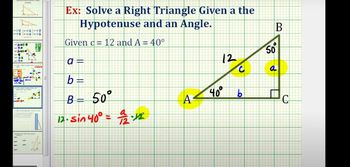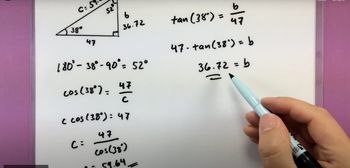Table of contents
- 0. Review of College Algebra4h 43m
- 1. Measuring Angles39m
- 2. Trigonometric Functions on Right Triangles2h 5m
- 3. Unit Circle1h 19m
- 4. Graphing Trigonometric Functions1h 19m
- 5. Inverse Trigonometric Functions and Basic Trigonometric Equations1h 41m
- 6. Trigonometric Identities and More Equations2h 34m
- 7. Non-Right Triangles1h 38m
- 8. Vectors2h 25m
- 9. Polar Equations2h 5m
- 10. Parametric Equations1h 6m
- 11. Graphing Complex Numbers1h 7m
2. Trigonometric Functions on Right Triangles
Solving Right Triangles
Problem 16
Textbook Question
Solve each right triangle. When two sides are given, give angles in degrees and minutes. See Examples 1 and 2.
 Verified step by step guidance
Verified step by step guidance1
<Step 1: Identify the given sides of the right triangle. Let's denote them as a (adjacent), b (opposite), and c (hypotenuse).>
<Step 2: Use the Pythagorean theorem, \( a^2 + b^2 = c^2 \), to verify the relationship between the sides or to find the missing side if only two sides are given.>
<Step 3: Calculate one of the non-right angles using trigonometric ratios. For example, use \( \tan(\theta) = \frac{b}{a} \) to find angle \( \theta \) or \( \sin(\theta) = \frac{b}{c} \) or \( \cos(\theta) = \frac{a}{c} \).>
<Step 4: Convert the angle from decimal degrees to degrees and minutes if necessary. This involves taking the decimal part of the degree and multiplying by 60 to get minutes.>
<Step 5: Use the fact that the sum of angles in a triangle is 180 degrees to find the other non-right angle, knowing that one angle is 90 degrees.>
Recommended similar problem, with video answer:
 Verified Solution
Verified SolutionThis video solution was recommended by our tutors as helpful for the problem above
Video duration:
0m:0sPlay a video:
Was this helpful?
Key Concepts
Here are the essential concepts you must grasp in order to answer the question correctly.
Right Triangle Properties
A right triangle is defined by one angle measuring 90 degrees. The other two angles are complementary, meaning they add up to 90 degrees. The sides of a right triangle are categorized as the opposite side, adjacent side, and hypotenuse, which is the longest side opposite the right angle. Understanding these properties is essential for applying trigonometric functions to solve for unknown angles and sides.
Recommended video:

30-60-90 Triangles
Trigonometric Ratios
Trigonometric ratios relate the angles of a triangle to the lengths of its sides. The primary ratios are sine (sin), cosine (cos), and tangent (tan), defined as follows: sin(θ) = opposite/hypotenuse, cos(θ) = adjacent/hypotenuse, and tan(θ) = opposite/adjacent. These ratios are fundamental for calculating unknown angles and sides in right triangles when two sides are known.
Recommended video:

Introduction to Trigonometric Functions
Angle Measurement in Degrees and Minutes
Angles can be measured in degrees, where one full rotation is 360 degrees. For more precision, angles can also be expressed in degrees and minutes, where one degree is divided into 60 minutes. This format is particularly useful in trigonometry for providing exact angle measures when solving triangles. Understanding how to convert between these measurements is crucial for accurate calculations.
Recommended video:

Reference Angles on the Unit Circle

 4:18m
4:18mWatch next
Master Finding Missing Side Lengths with a bite sized video explanation from Nick Kaneko
Start learningRelated Videos
Related Practice














